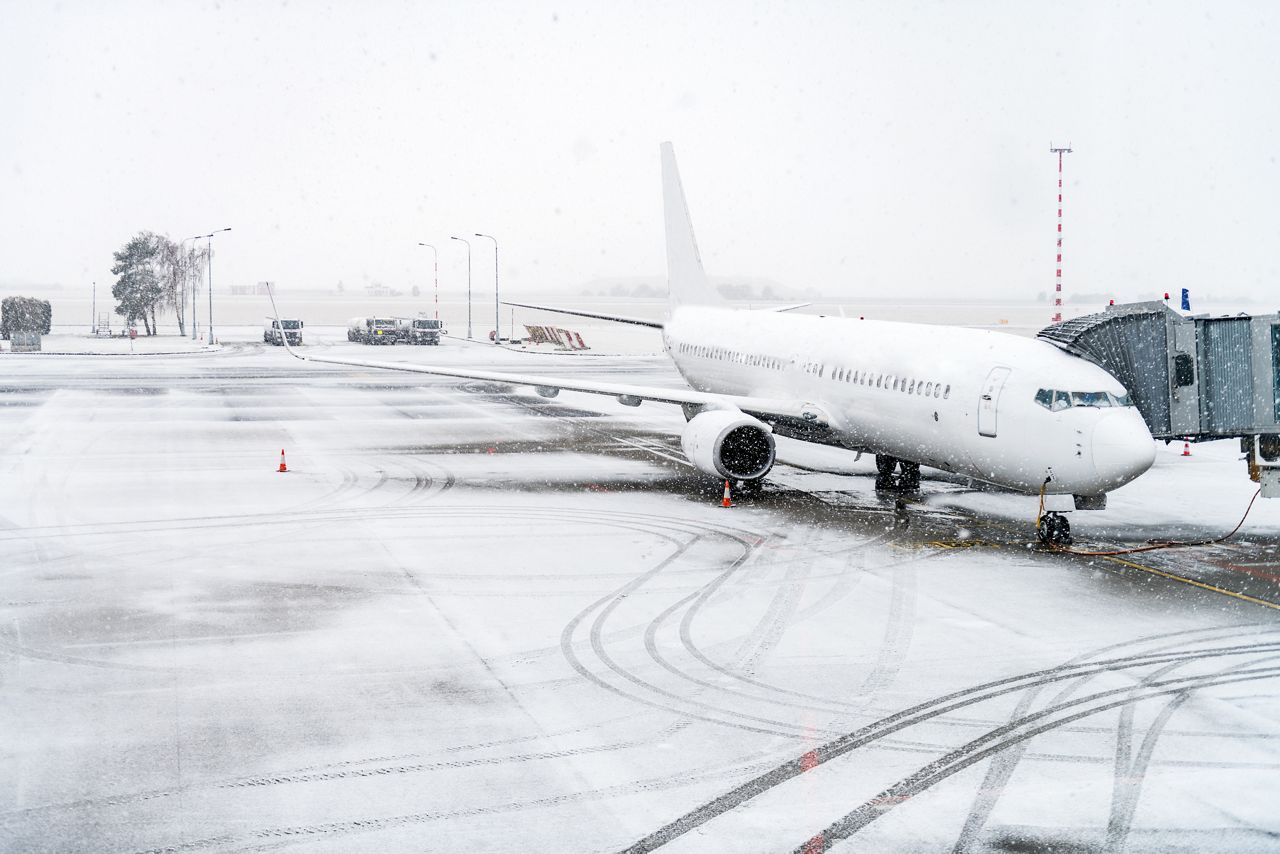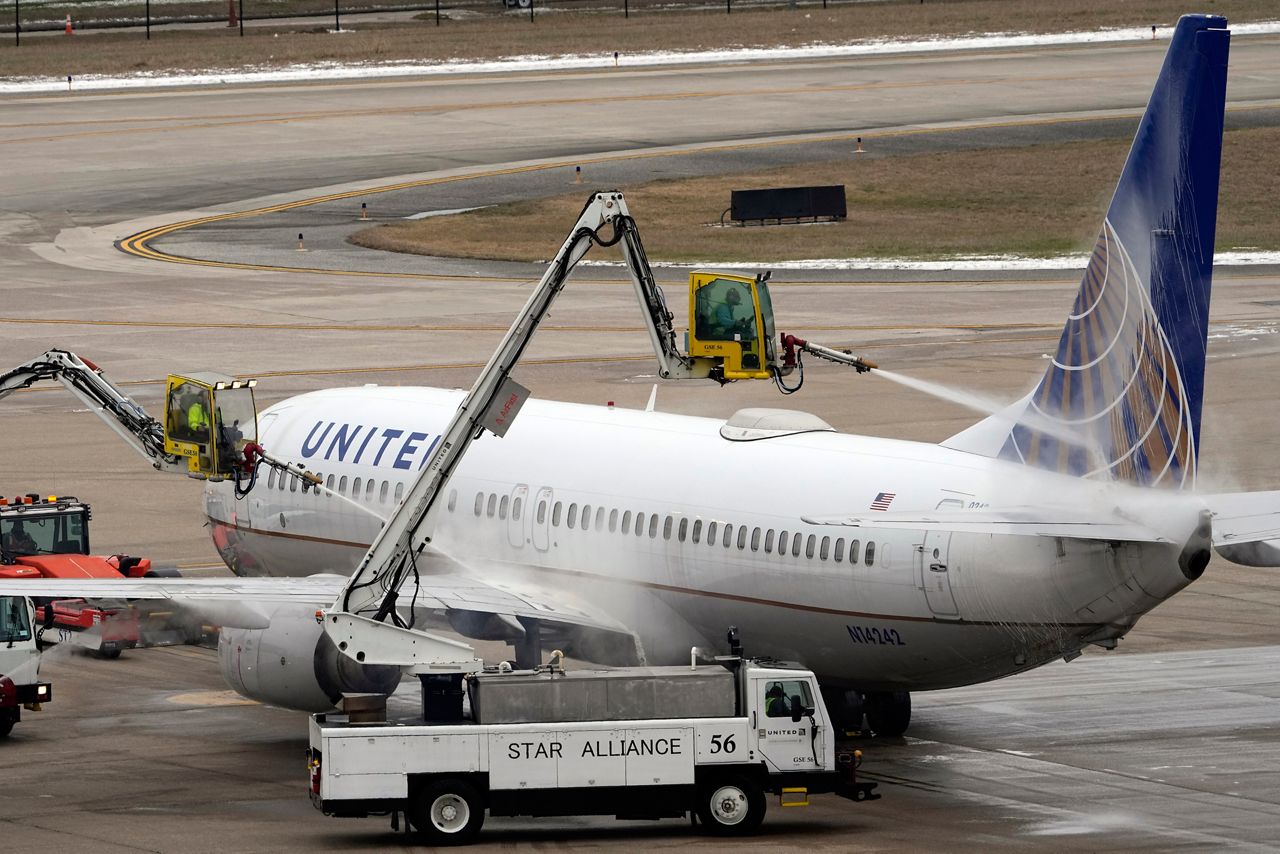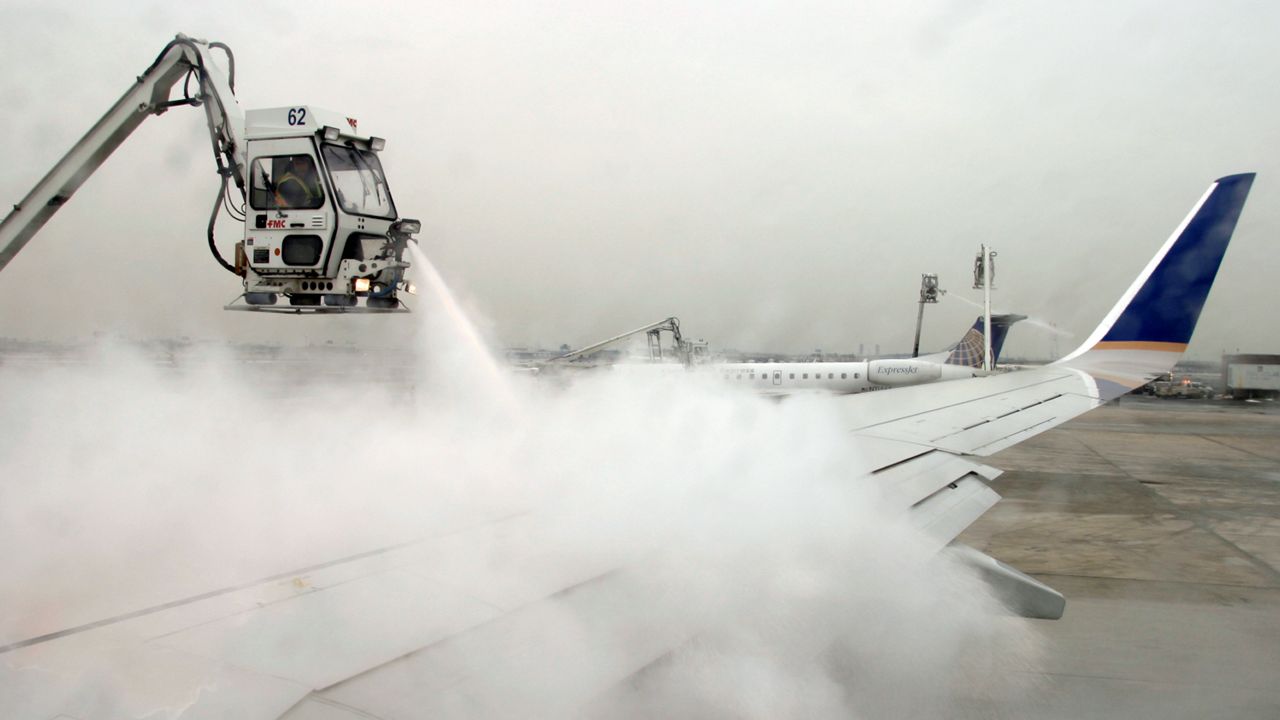Last call for boarding! Air travel may be stressful for some and a breeze for others, no matter the time of year. But wintertime travel comes with some extra baggage: winter weather and the frigid temperatures.
A major winter storm is bound to cause widespread delays and cancellations, but the cold alone shouldn't bring many holdups. At least not anymore, thanks to a process called de-icing.
Of course, it's no surprise that powerful winds, wintry precipitation and blizzard-like conditions generated by a potent winter storm are enough to keep planes grounded at the gate. The risks of flying in such conditions are too great. But what about the cold alone?

An aircraft is built to withstand frigid temperatures. If you've ever checked out the flight map and information onboard, you might already know this. When the plane reaches higher altitudes, it flies through bitterly cold temperatures–not just in the winter, but year-round!
Soaring through temperatures as cold as -70 degrees at 40,000 feet is no problem for modern aircraft. In fact, planes can actually perform better in the cold, as this denser air allows for more lift and for the engine to operate more efficiently. In the air, that is.
On the ground, severely cold temperatures can threaten a safe takeoff or landing, especially when moisture is involved. The solution (literally) to prevent this? De-icing.
When temperatures fall below freezing, any moisture that comes into contact with the cold metal surface of the aircraft will freeze.
While this might not seem like a big deal initially, layers of ice and wintry precipitation could impact the instrumentation and functioning of the aircraft itself, reducing its ability to fly safely. To prevent this, we must de-ice a plane.
If you travel during the winter months, chances are you probably heard the term before. But what is de-icing?
The Federal Aviation Administration (FAA) defines de-icing as removing ice from an aircraft after it has formed. This doesn’t just refer to the removal of ice alone, but also includes the removal of any snow or frost that built up on the surface of the aircraft.
This process is essential to ensure a safe flight.
Jim Decker, United Airlines Director of Ramp Operations at Dulles International Airport in Virginia, describes the typical de-icing process, which usually involves two solutions: Type I and Type IV.
When temperatures are below freezing, they use a Type I solution first, which comprises 50% propylene glycol and 50% water. The solution is heated and sprayed on the aircraft to remove ice or snow from the aircraft.
If freezing precipitation is falling as the plane gets ready for takeoff, they will spray the plane again, only this time with the Type IV solution, which is 100% glycol, preventing ice and snow from adhering to the wings and tail of the plane.
Decker clarifies that this solution "is not sprayed across the entire aircraft, but rather just the critical areas, such as the wings and the tail."

The FAA mandates that all aircraft are free from ice, snow and frost prior to takeoff, commonly known as the "clean aircraft concept." Failure to abide by this could lead to devastating consequences.
Decker adds, "If there is ice or snow on the wings or tail of a plane, that can prevent the plane from having enough lift to takeoff safely, so de-icing is very important when the weather gets colder. Without lift, planes can’t become and stay airborne.”
Unfortunately, not properly de-icing an aircraft in the past resulted in catastrophic outcomes.
On Jan. 13 1982, failure to de-ice a plane once more prior to takeoff led to a deadly disaster in our nation’s capital.
Following a winter storm, a delayed Air Florida Flight heading to Fort Lauderdale attempted to take off. It was only in the air for a short time before it crashed into the 14th Street Bridge over the Potomac River. The disaster that took 78 lives that day was due to pilot error.
Even though the plane was initially de-iced, delays prolonged its time sitting out on the tarmac. Because of this, it needed to be de-iced again prior to takeoff.
Decker highlights the importance behind the “holdover time” and how it determines the frequency of which planes should be de-iced given the weather conditions on that day.
He explains, “After a plane is de-iced, a clock is set for holdover time, which measures the time between when the team sprayed the Type IV fluid to the time that the aircraft actually takes off from the runway. The holdover time is determined by the precipitation, temperature and aircraft type. The colder it is, the shorter the holdover time is.”
Decker expresses that "If the plane waits too long to take off at an airport and exceeds its holdover time, it may need to be sprayed again prior to being able to take off.”
In another instance, ice building up on the wings also lead to the fatal crash of Flight 3470 that was headed to Buffalo back in Feb. 2009.
Even when the plane takes off safely, pilots still need to be aware of ice forming on the plane while in flight as well. Thus, it is essential they must pay close attention to the current weather conditions, as well as the ones that they could encounter en route to their destination.
Knowledge of the types of icing and how they can impact an aircraft's performance are key to making sure everyone onboard stays safe. To learn more about the different types of icing and its potential hazards, the National Weather Service (NWS) breaks it all down here.
As a peace of mind, though, most commercial aircraft nowadays have in-flight de-icing systems that prevent this from happening.
Combating the cold takes careful preparation, which is why airlines have specially designated teams dedicated only to its de-icing procedures.
Decker discusses how United’s de-icing crews train thoroughly in the summer months in order to prepare for winter operations. Even though these teams are ready to go in the fall, the busiest times are by far during the months of December and January.
Regardless, standard regulations require planes to de-ice when temperatures fall below freezing. Still, Decker reminds us that this process is “a calibration between the de-icing team and the pilots. But ultimately, the pilots inspect planes ahead of departure to determine whether de-icing is necessary.”
The total time to de-ice a plane can range from under 10 minutes to 25 minutes for smaller jets, but could take as long as 45 minutes for wide-body aircraft. So, the decision to de-ice a second time before takeoff could cause a late arrival to your destination.
Despite the additional delays de-icing may bring, though, at least it shouldn’t put a total freeze on your winter travel plans.
Our team of meteorologists dives deep into the science of weather and breaks down timely weather data and information. To view more weather and climate stories, check out our weather blogs section.
Shawnie Caslin - Digital Meteorologist
Shawnie joined Spectrum News as a Digital Meteorologist in 2021. After discovering her love for weather as a child, she earned a Bachelor's of Science in Meteorology from Rutgers University in 2015. Prior to joining Spectrum, Shawnie worked behind the scenes at local and national networks as a meteorologist and weather graphics producer in New York City. She thoroughly enjoys working in the media and is always passionate to explore the different ways weather impacts our everyday lives.









